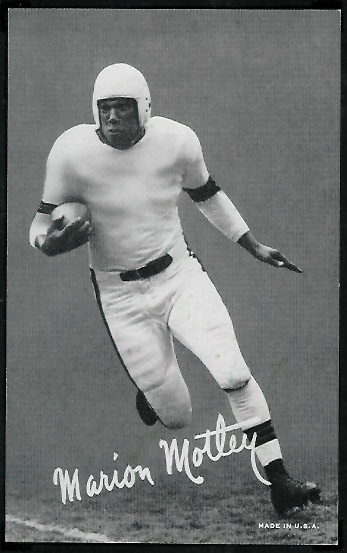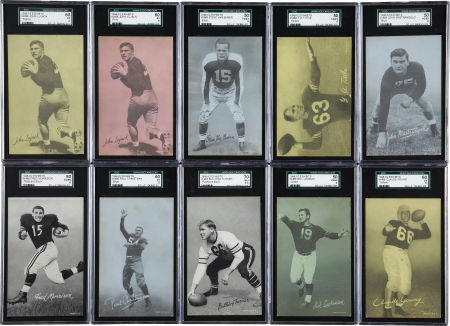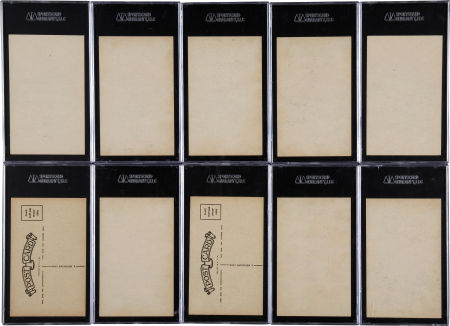Marion Motley and Other Exhibit Cards
July 8th, 2010 | Published in Football Card Trivia, Sites I Like, Uniforms
 I picked up this card a couple of weeks ago; it’s an Exhibit card of Marion Motley, printed between 1948 and 1952. Motley was one of the first four African Americans to play professional football, and he was the second African American to be inducted into the Pro Football Hall of Fame. (Em Tunnell was the first.)
I picked up this card a couple of weeks ago; it’s an Exhibit card of Marion Motley, printed between 1948 and 1952. Motley was one of the first four African Americans to play professional football, and he was the second African American to be inducted into the Pro Football Hall of Fame. (Em Tunnell was the first.)
This is one of my first Exhibit cards, and I’m finding that there is a lot to learn about them. A good place to start is Adam Warshaw’s page called “Interesting Exhibit Cards.” Adam’s article provides a nice introduction to the cards, along with many, many pictures. According to his article, “Exhibit cards were the first nationally distributed sports card product sold without any ancillary uses or purposes,” meaning that they were not used to help sell some other product. Football players were just a few of the people featured on Exhibit cards: there were other athletes, movie stars, musicians, and, well, just see Adam’s page. Exhibit cards were dispensed from vending machines, and you can see pictures of a few of the machines on photobucket.
When I bought the Motley card, I assumed that it was a pre-rookie card, and I intended to add it to my pre-rookie cards page. I am not sure now, though, that it was printed before his 1950 Bowman rookie card. Exhibit cards don’t have dates printed on them, but by looking for slight variations, you apparently can narrow down the possible printing dates. According to a page at centuryoldcards.com, the size and case of the “MADE IN THE U.S.A.” line on the bottom of Exhibit baseball cards indicates when they were printed. The “MADE IN THE U.S.A.” line on my Motley card is all in upper case, and it measures 5/8 of an inch horizontally, suggesting that the card was printed in 1948–if football cards had the same variations as baseball cards. My old Beckett catalog, though, says that 1948 Exhibit football cards had a line at the bottom describing the player. (See eBay for examples.) In fact, my Beckett catalog distinguishes the 1948 cards from the 1949-1952 cards, saying that the 1948 cards are from the “Exhibit Sports Champion” set. Since the guidelines at centuryoldcards.com don’t appear to jibe with Beckett when applied to football cards, I’m not certain when my card was printed.
I get the sense that Beckett created a separate set for the 1948 Exhibit cards because they were easy to distinguish from the later years. The variations in the text on the 1949-1952 cards are less obvious, and I’m guessing that that’s why Beckett lumped those years together. The other card guides group all of the Exhibit football cards together and call them 1948-1952 Exhibits. To me that makes sense, since there were a lot of variations among the cards, and no one seems to have a firm grasp on which cards were printed with which variations. Besides the variations mentioned above, some cards were printed with different tints, and some were printed with postcard backs. The small images here show some variations from a recent Heritage Auctions listing. (The listing also includes larger images, but you have to register to see them.)


Back to my Motley card: I wondered about his number-less jersey, so I did some searching for it. I thought that maybe it was an old college jersey, or that maybe the Browns didn’t wear numbers in their early days in the AAFC. I didn’t find the image anywhere else, though, and I concluded that it was a Browns practice jersey. Blackpast.com has a photo of Motley in action as a Brown, and the jersey number is the only difference between the uniform he is wearing in that photo and the one he is wearing on my card. It’s curious that the Exhibit card pictures him in a practice jersey, but the all-white uniform does make for a striking image.
You might have noticed that, in the image at blackpast.com, Motley is wearing Chuck Taylors. The Browns evidently wore Chucks when the field was frozen, because I found an image of other team members changing into them during the 1950 Championship game. I believe number 59 is Horace Gillom–check out his monster facemask!
- Search eBay for Marion Motley, 1948-1952 Exhibit football cards
